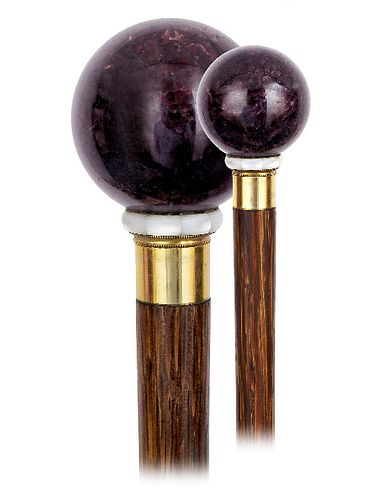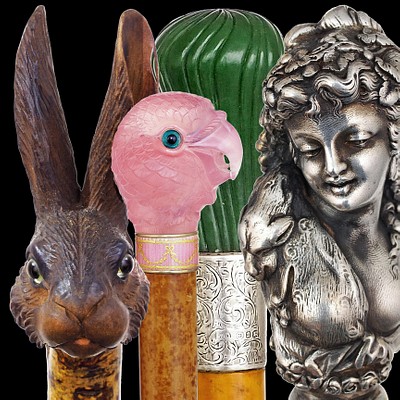Hardstone Dress Cane
Lot 86
About Seller
Kimball Sterling
125 West Market Street
Johnson City, TN 37604
United States
Family-owned and family-run Johnson City Tennessee auction business for 25 years. Selling antiques and collectables for 38 years. Kimball M. Sterling, Inc. was founded and is owned by Kimball and Victoria Sterling, time and again, they have laid solid claim to world-wide attention and renown with an...Read more
Categories
About Auction
By Kimball Sterling
Feb 22, 2023 - Mar 12, 2023
Set Reminder
2023-02-22 00:00:00
2023-03-12 00:00:00
America/New_York
Bidsquare
Bidsquare : Passed Cane Auction
https://www.bidsquare.com/auctions/kimball-sterling/passed-cane-auction-12307
Selection of fine canes
Kimball Sterling kimballsterling@earthlink.net- Lot Description
-Ca. 1920 -Large garnet ball knob with a smooth and polished surface displaying an enigmatic, crystallized structure and the typical, deep red color with dark hues. The ball is tastefully mounted with a bright and shimmering mother of pearl ring and gilt metal collar on a coco palm wood shaft and a horn ferrule. -Exclusivity closer than ever, this cane distinguishes with the bold use of volume and color. It represents the selective cane collector criteria of creativity, craftsmanship, originality and decorative appeal and survived intact and with its entire initial sparkle. Noteworthy is that garnets of this size are excessively rare and a favorite of gem collectables. -Canes with hard stone ball knobs became very popular after WWI. They were generally seen as mascots, likely to be chosen individually for personal reasons and their endless varieties make them great and decorative collectables. -H. 2 ½” x 2”, O.L. 37 ¼” -$800-$1,000 -Hardstones, or semiprecious stones, constitute a special group, generally opaque, which includes some of the most beautiful of all substances. The definition of “hardstone” is not very rigid, but excludes “soft” stones such as soapstone and minerals such as alabaster, both widely used for small carving and decorative purposes. The term is derived from a literal translation of the Italian plural “pietre dure”, which in Italian covers all hardstone carving. -Born to the house of Mars and the month of January, the garnet is the stone of inspiration and energy. Its red stones are like the ripe round polyps of a pomegranate. And, fittingly, that is where garnet derives its name, from the Latin word granatum meaning seed-like, like the seeds of a pomegranate. Its value lies in its purity of color and lack of inclusions. Healer and protector, it promotes loyalty, devotion and sincerity. In the thirteenth century, the blood red pyrope garnet were thought to be effective insect repellents. To prove the authenticity of a garnet, owners would take off their clothes and smear their bodies with honey. If insects did not swarm them, the garnet was real.
- Shipping Info
-
Each auction has different shipping terms but the buyer always pays.
Canes:
After payment has been received we will contact you.
-
- Buyer's Premium



 EUR
EUR CAD
CAD AUD
AUD GBP
GBP MXN
MXN HKD
HKD CNY
CNY MYR
MYR SEK
SEK SGD
SGD CHF
CHF THB
THB














